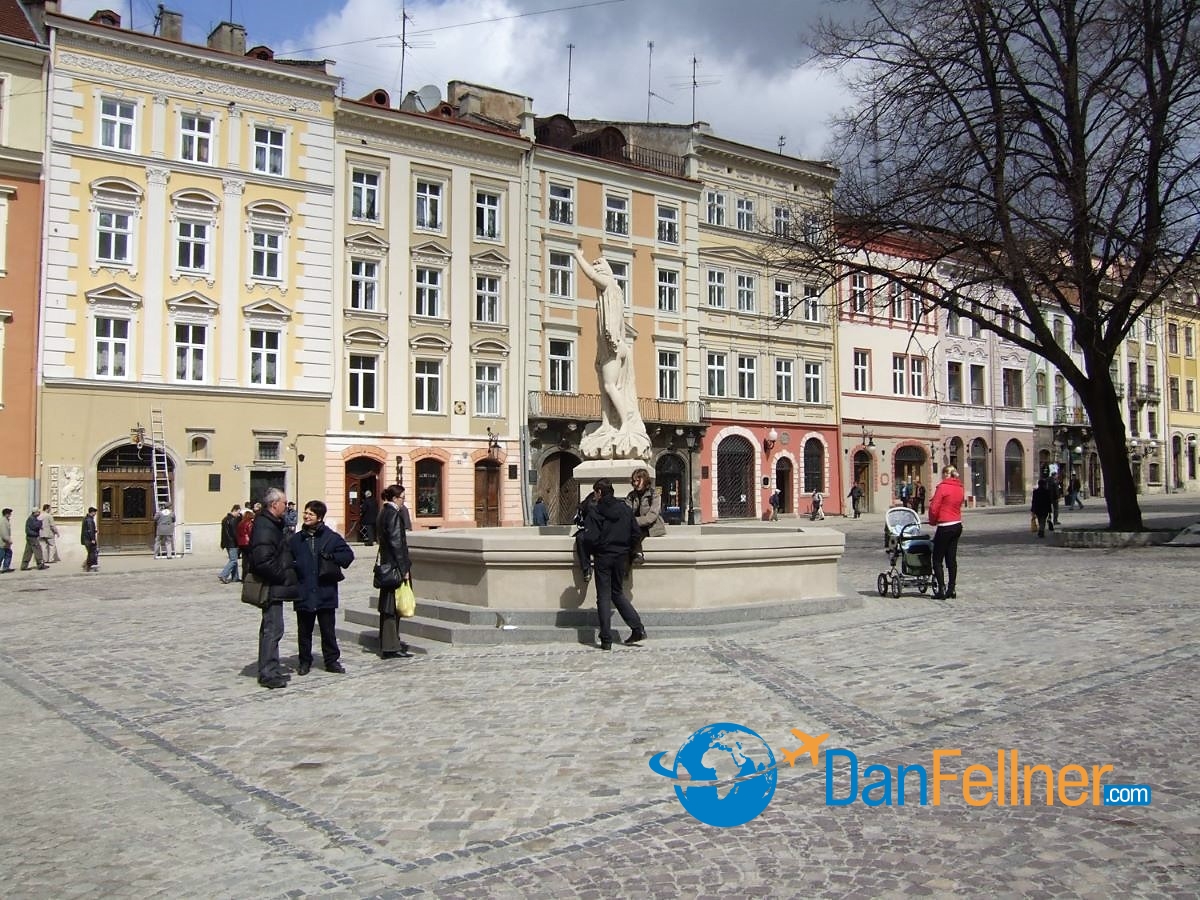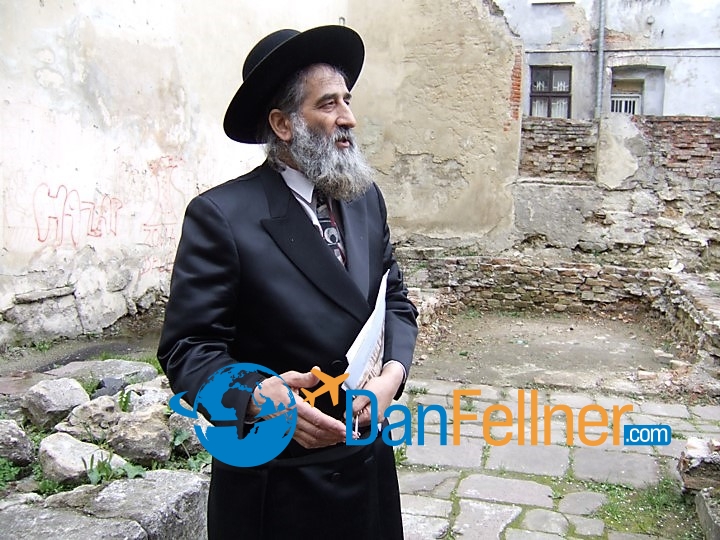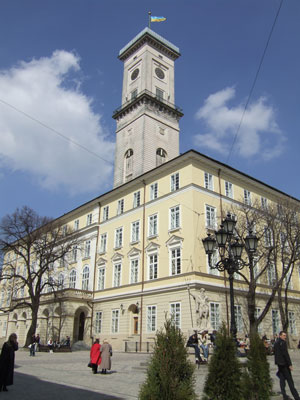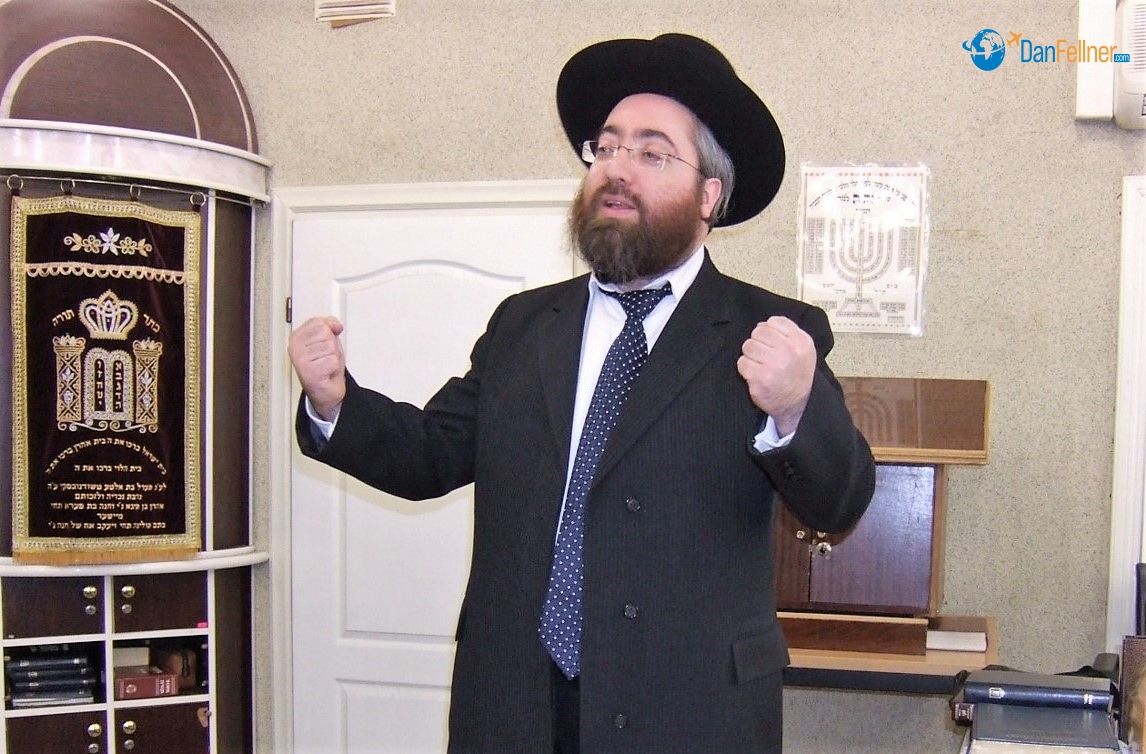The soul of erstwhile Jewish Galicia can yet be conjured up with a trip to one of the region’s principal—and still resplendent—capitals of culture.
Hadassah Magazine – April, 2008
It’s early evening and a small minyan is chanting Minha inside Bais Aron V’Yisroel, Lviv’s only active synagogue. Led by Chief Rabbi Mordechai Shlomo Bald, the men say the same prayers Jews have been reciting for centuries in this western Ukrainian city that was once the hub of Jewish culture in Galicia.

Lviv’s Old Town has been named a UNESCO World Heritage Site for its variety of architectural styles.
Although the number of practicing Jews is now a tiny fraction of what it was before the Holocaust, Bald and other Jewish leaders in Lviv are determined to reinvigorate the community and preserve its rich Jewish past.
For visitors, a number of sights evoke memories of the area’s vibrant—and tragic—Jewish heritage.
This city of 800,000, known as Lvov in Russian, suffered relatively little damage in World War II. The result is an Old Town, anchored by cobblestoned Rynok Square, featuring more than 40 buildings in a variety of architectural styles—Renaissance, Baroque, classic and Art Nouveau.
With ornate fountains, red-roofed buildings and green-domed churches, Lvov bears some resemblance to Florence. Indeed, UNESCO, which has made Old Town a World Heritage Site, described Lvov as “an outstanding example of the fusion of the architectural and artistic traditions of Eastern Europe with those of Italy and Germany.”

Rynok Square in the heart of Lviv, Ukraine.
History
Jews settled in Lviv soon after it was founded in the mid-13th century by Prince Danylo Halytsky of Galicia. The city took its name from the prince’s son, Lev. It is believed the principality’s early Jews arrived from Byzantium and Asia Minor (modern-day Turkey) and neighboring lands.

A monument at the site of the Jewish ghetto in Lviv, Ukraine.
One hundred years later, Lviv was renamed Lwow when it was taken over by Casimir the Great of Poland, who gave Jews equal rights. Jews from Germany fleeing the plague and persecution began arriving, soon becoming prominent in trade and handicrafts.
By the end of the 14th century, Lviv, a walled city, had two Jewish settlements, one inside the walls, one outside. The two areas maintained separate synagogues and mikves but shared a cemetery. By 1550, about 1,000 Jews lived in Lviv.
In the early 17th century, a violent conflict arose between the Jews and Jesuits over the Golden Rose Synagogue, which had been constructed in 1582 inside the city walls by the Nachmanovich family. The Jesuits claimed for themselves the land on which the synagogue was built; however, the Jews were able to refute the charge, and the synagogue remained standing until the Holocaust.
Galicia became part of the Hapsburg Austro-Hungarian Empire in 1772, when Lviv again changed names, this time to Lemberg. Jewish rights were curtailed and, by 1800, only wealthy and educated Jews who adopted the German way of life were allowed to live outside the city’s Jewish quarter (by this time, the distinction between the communities inside and outside the walls had ceased to exist, and the main quarter was outside the walls). Most Jews earned a living as shopkeepers or craftsmen.

Meylakh Sheykhet at the ruins of the Golden Rose Synagogue, which was constructed in 1582.
At the end of the 18th century, Lviv became a center of the Hasidic movement and, in 1844, a Reform temple opened. By 1910, the Jewish population was 57,000.
At the end of World War I, Jews were caught in the middle as Poles and Ukrainians fought for control of eastern Galicia. Pogroms broke out in 1918, leaving 70 Jews dead. Lviv eventually returned to Polish control between world wars. During this time, there were Jewish schools, newspapers and about 50 functioning synagogues. The Jewish population reached a high of 110,000 in 1939, one-third of Lviv’s total population.
When World War II began, Lviv came under Soviet control and the Jewish population swelled to more than 200,000, as refugees poured in from German-occupied Poland. The Germans captured the city in June 1941 and more than 6,000 Jews were killed almost immediately in pogroms carried out by the local population, fueled by rumors that Jews had participated in the execution of Ukrainian political prisoners.
In November 1941, the Germans set up a Jewish ghetto, which eventually had more than 100,000 occupants. Soon after, the Germans began transporting Jews from the ghetto to the Belzec death camp, 60 miles to the north in Poland. Thousands were also sent to the Janowska labor camp in the northern outskirts of Lvov where most were shot by firing squads. The Germans completely liquidated the ghetto in June 1943. By the time the Soviets recaptured Lviv in July 1944, only a few hundred Jews remained.
After the war, Jews slowly returned to Lviv from other parts of the Soviet Union, but religious expression was not allowed under Communism and anti-Semitism persisted. The postwar Jewish population reached a high of 30,000 in 1978, but has since dwindled due to emigration, primarily to Israel, Germany and America.
Community
About 5,000 Jews now live in Lviv, many elderly and impoverished. The Jewish community center, operated by the American Jewish Joint Distribution Committee, tries to assist with a variety of social services and educational programs. The center is housed in the four-story Hesed Arieh (Lvov Jewish House; 30 Kotlarevski Street; 011-380-322-389-860; which opened in 2004. Also on the premises is a one-room museum with photographs and Judaica, including a mid-19th-century Torah scroll. Ada Dianova, formerly a popular Ukrainian stage actress, is the facility’s director.

Rabbi Mordechai Shlomo Bald, the spiritual leader of Bais Aron V’Yisroel Synagogue since 1993.
Bald has led Bais Aron V’Yisroel Synagogue since 1993, when he was sent to Ukraine by the Karlin-Stolin rebbe. His wife, Sara, helped establish the Acheinu Lauder school, which now has an enrollment of about 60 children. The synagogue offers restaurant services by order for groups, families or individuals. It also organizes bus or car transportation, translators, guides, archive investigations and kosher food.
Community activist Meylakh Sheykhet, who heads the local bureau of the Union of Councils for Jewsof the Former Soviet Union, leads an Orthodox prayer group that meets in a building adjacent to the ruins of the Golden Rose Synagogue (54 Starojevrejskaja Street). There is also a small kosher canteen in the building. In addition to feeding the poor, the kitchen can provide kosher meals to visitors.
While Jewish leaders say that relations with most of the community at large are positive, there remains an undercurrent of anti-Semitism in Lviv. Jewish monuments and buildings are regularly vandalized and anti-Semitic slogans appear on fences and walls throughout the city.
Sights
Bais Aron V’Yisroel, a modest yellow building not far from the train station (4 Brothers Miknovski Street; 380-322-383-804), was built in 1924. Architect Aba Kornbluth designed it in the tradition of Renaissance synagogues of the 17th century. The Nazis used the building as a stable and the Communists later converted it into a warehouse. It was returned to the Jewish community in 1989.

Bais Aron V’Yisroel, Lviv’s only active synagogue.
Inside the synagogue, there are a number of hand-painted frescoes depicting animals, birds, a Torah and other Jewish symbols. The frescoes suffered significant damage due to many years of neglect during Soviet times but were recently brought back to splendor as part of a major interior restoration project under the supervision of architect Aron Ostreicher, who is known for reconstructing synagogues around the world. Funding was provided by American George Rohr and other philanthropists. Bais Aron V’Yisroel was rededicated in late 2007.
The Golden Rose Synagogue, which for centuries was the center of Jewish culture in Lviv, was burned down by the Nazis in 1942. Part of the structure’s northern wall has survived and it bears a plaque written in English, Hebrew and Ukrainian. Sheykhet is raising money to clean up debris at the site and conduct an archaeological excavation in hopes of recovering Jewish artifacts dating back more than 400 years.
Little remains of the old Jewish quarter of Lviv. A pink building at 3 Ugolna Street is the site of a mid-19th-century synagogue, yeshiva and mikve. It survived the Holocaust and was the city’s only functioning synagogue between 1945 and 1962, when it was closed by the Soviets.
Two other prominent synagogues that did not survive the Holocaust are recalled today with markers.

There remains an undercurrent of anti-Semitism in Lviv — Jewish monuments and buildings are regularly vandalized.
In the Old Market Square, near where the city was founded in the 13th century, a plaque marks the location of what was the largest Reform synagogue in Galicia. A few blocks away, near an outdoor market at the corner of Sanska and Vesela Streets, is the site of the former Hasidic Grand Synagogue, originally built in the 17th century. Both structures were destroyed in 1941.
One of the more exotic looking buildings in the city, the former Jewish Hospital (8 Rappaport Street), was built in 1904. It features a Moorish-style multicolored dome decorated with Stars of David. The building still functions as a gynecological hospital.
A memorial to the victims of the Lvov ghetto stands at Chornovola Street, near the railroad bridge. Built in 1992 with government funding, at one end of the monument there is a large statue of a Jew staring up at the heavens with one hand open in hope, the other clenched in protest. A menora at the front of the memorial is inscribed in Ukrainian with the words “remember and keep in your heart.”
The Museum of the History of Religions (1 Muzeina Street) displays about 50 items of Judaica, including an early-20th-century matza-making device. Thousands of other artifacts confiscated from the Jewish community during the Communist era, many never seen by the public, remain stored in Lviv museums. Jewish leaders are petitioning the government for their return.
About 15 minutes by car from Old Town is the site of the Janowska labor camp. A large memorial stone inscribed with “200,000” recalls the number of people who were murdered there, most of them Jews.
Other Sights
For a stunning view of Old Town and the green-domed churches below, climb the wooden staircase in the clock tower in the 19th-century Town Hall, in Rynok Square.

Lviv’s Town Hall Clock Tower.
The ornate Ivan Franko Opera and Ballet Theater, built at the turn of the 20th century, is located at the north end of the city’s main street, Prospect Svobody (Freedom Avenue). There are several performances a week.
Side Trip
About 20 miles north of Lviv is Zhovkva, a former artists’ colony. Jews settled there at the end of the 16th century and, in 1700, built the Grand Synagogue, one of the largest in Galicia. Its interior was mostly destroyed in the Holocaust, but its pink Renaissance-style exterior and some inner frescoes of Torah passages as well as the Ark have survived. The building was partially restored after the war and converted into a furniture store. It now sits empty.
Drive 85 miles south of Lviv to reach Ivano-Frankivsk, a metropolis of about 200,000 residents named after the famous Ukrainian poet Ivan Franko. The town is the major gateway into the Carpathian Mountains, where hiking and skiing are popular activities. The mountain area also offers the opportunity to see rural Ukrainian villages that time seems to have forgotten.
Personalities
Yiddish writer Sholem Aleichem, whose short stories were the basis for Fiddler on the Roof, lived in Lviv for several months in 1906 and was involved with the Yiddish theater there. The site of his residence, an apartment building at 1 Kotljarska Street, bears a large plaque honoring its former tenant.
Plaque at the former home of Sholem Aleichem in Lviv.
Martin Buber, the Jewish philosopher and social activist, was born in Vienna in 1878 but spent much of his childhood in Lviv with his grandfather Solomon Buber, a renowned scholar in his own right. Martin Buber wrote about Zionism, Hasidism and is perhaps best known for his essay on existence, “I and Thou.”
Nazi hunter Simon Wiesenthal was living in Lviv when the Nazis invaded in 1941. He and his wife were imprisoned in Janowska , from which Wiesenthal escaped in 1943. He fought with the partisans before being recaptured in 1944. Two years after being liberated from the Mauthausen concentration camp, he helped establish the Jewish Documentation Center in Austria. Wiesenthal, author of The Sunflower: On the Possibilities and Limits of Forgiveness (Schocken), later moved to the United States and dedicated his life to bringing Nazi war criminals to justice.
Books, Films
Eliah Yones provides an in-depth account of the Holocaust in Lviv in Smoke in the Sand: Jews of Lvov in the War Years, 1939-1944 (Gefen). After escaping the Lviv ghetto to the nearby forests, Yones joined the partisans in fighting the Germans. His book details the role of the Judenrat (Jewish council), which provided work for as many as 5,000 people in the ghetto at one time.
Robert Marshall’s In the Sewers of Lvov: A Heroic Story of Survival From the Holocaust (Scribner) chronicles the plight of 20 Jews who survived by hiding for more than a year in the city’s sewer system.
The Jews of Poland—Five Cities: Bialystok, Lvov, Krakow, Vilna and Warsaw (Ergo) is a documentary account of the vibrancy of Jewish life in the region before the Holocaust. It was filmed in 1938-1939 and is available in both Yiddish and English.
More recently, portions of Schindler’s List were shot in Lviv’s Old Town, as production costs there were lower than in Krakow, where the story is set.
Recommendations
Tour guide Alexander Denisenko, owner of Travel Ukraine Agency (380-506-710-725), has studied at Yad Vashem, The Holocaust Martyrs’ and Heroes’ Remembrance Authority in Israel and is an expert on the Holocaust and Jewish sights in the region. He can also help with genealogy research at the local branch of the Ukrainian Central Historical Archive (3 Soborna Street), the largest repository of genealogical information about Jews in Galicia.
There are no kosher restaurants in Lviv, although Seven Piglets (9 Bandera Street; 380-322-975-507) is a good choice for authentic Ukrainian cuisine and offers several vegetarian options.

A meat market in Lviv, Ukraine.
The Opera Hotel (45 Prospect Svobody; 380-322-259-000), located across the street from the Ivan Franko theater, is a newer establishment with clean and comfortable rooms and within walking distance of most Jewish attractions.
There are no direct flights from the United States to Lviv, but there are connections from Vienna, Frankfurt and Warsaw. as well as train and bus connections from Kiev, Odessa, Krakow and other East European cities.
However one arrives, it is worth spending several days in Lviv. Strolling down the cobblestoned streets in the Old Town and admiring the eclectic architecture is perhaps the city’s greatest pleasure.
Visiting Lviv also presents an opportunity to see a Jewish community that, despite serious challenges, courageously continues to observe centuries-old traditions.



